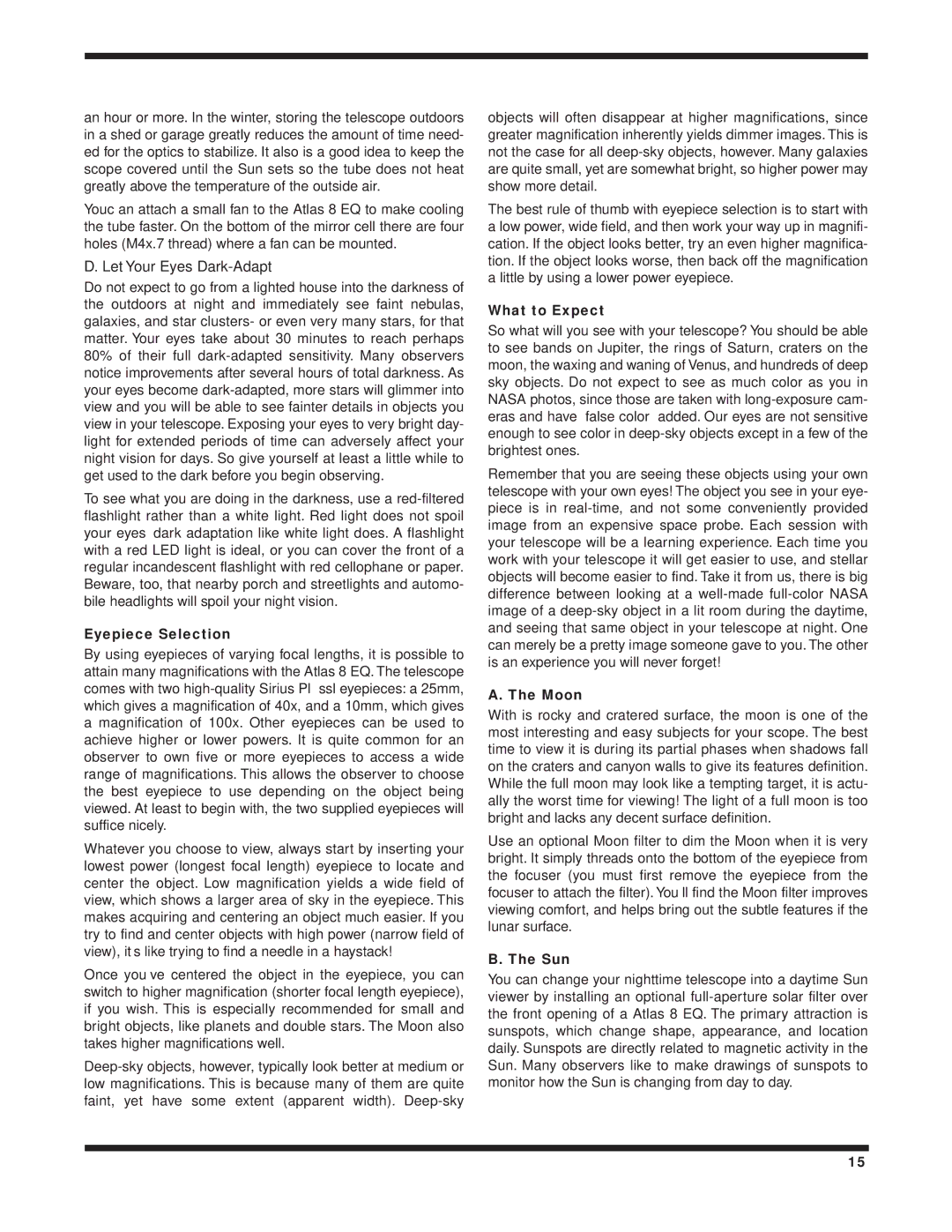
an hour or more. In the winter, storing the telescope outdoors in a shed or garage greatly reduces the amount of time need- ed for the optics to stabilize. It also is a good idea to keep the scope covered until the Sun sets so the tube does not heat greatly above the temperature of the outside air.
Youc an attach a small fan to the Atlas 8 EQ to make cooling the tube faster. On the bottom of the mirror cell there are four holes (M4x.7 thread) where a fan can be mounted.
D. Let Your Eyes Dark-Adapt
Do not expect to go from a lighted house into the darkness of the outdoors at night and immediately see faint nebulas, galaxies, and star clusters- or even very many stars, for that matter. Your eyes take about 30 minutes to reach perhaps 80% of their full
To see what you are doing in the darkness, use a
Eyepiece Selection
By using eyepieces of varying focal lengths, it is possible to attain many magnifications with the Atlas 8 EQ. The telescope comes with two
Whatever you choose to view, always start by inserting your lowest power (longest focal length) eyepiece to locate and center the object. Low magnification yields a wide field of view, which shows a larger area of sky in the eyepiece. This makes acquiring and centering an object much easier. If you try to find and center objects with high power (narrow field of view), it’s like trying to find a needle in a haystack!
Once you’ve centered the object in the eyepiece, you can switch to higher magnification (shorter focal length eyepiece), if you wish. This is especially recommended for small and bright objects, like planets and double stars. The Moon also takes higher magnifications well.
objects will often disappear at higher magnifications, since greater magnification inherently yields dimmer images. This is not the case for all
The best rule of thumb with eyepiece selection is to start with a low power, wide field, and then work your way up in magnifi- cation. If the object looks better, try an even higher magnifica- tion. If the object looks worse, then back off the magnification a little by using a lower power eyepiece.
What to Expect
So what will you see with your telescope? You should be able to see bands on Jupiter, the rings of Saturn, craters on the moon, the waxing and waning of Venus, and hundreds of deep sky objects. Do not expect to see as much color as you in NASA photos, since those are taken with
Remember that you are seeing these objects using your own telescope with your own eyes! The object you see in your eye- piece is in
A. The Moon
With is rocky and cratered surface, the moon is one of the most interesting and easy subjects for your scope. The best time to view it is during its partial phases when shadows fall on the craters and canyon walls to give its features definition. While the full moon may look like a tempting target, it is actu- ally the worst time for viewing! The light of a full moon is too bright and lacks any decent surface definition.
Use an optional Moon filter to dim the Moon when it is very bright. It simply threads onto the bottom of the eyepiece from the focuser (you must first remove the eyepiece from the focuser to attach the filter). You’ll find the Moon filter improves viewing comfort, and helps bring out the subtle features if the lunar surface.
B. The Sun
You can change your nighttime telescope into a daytime Sun viewer by installing an optional
15
